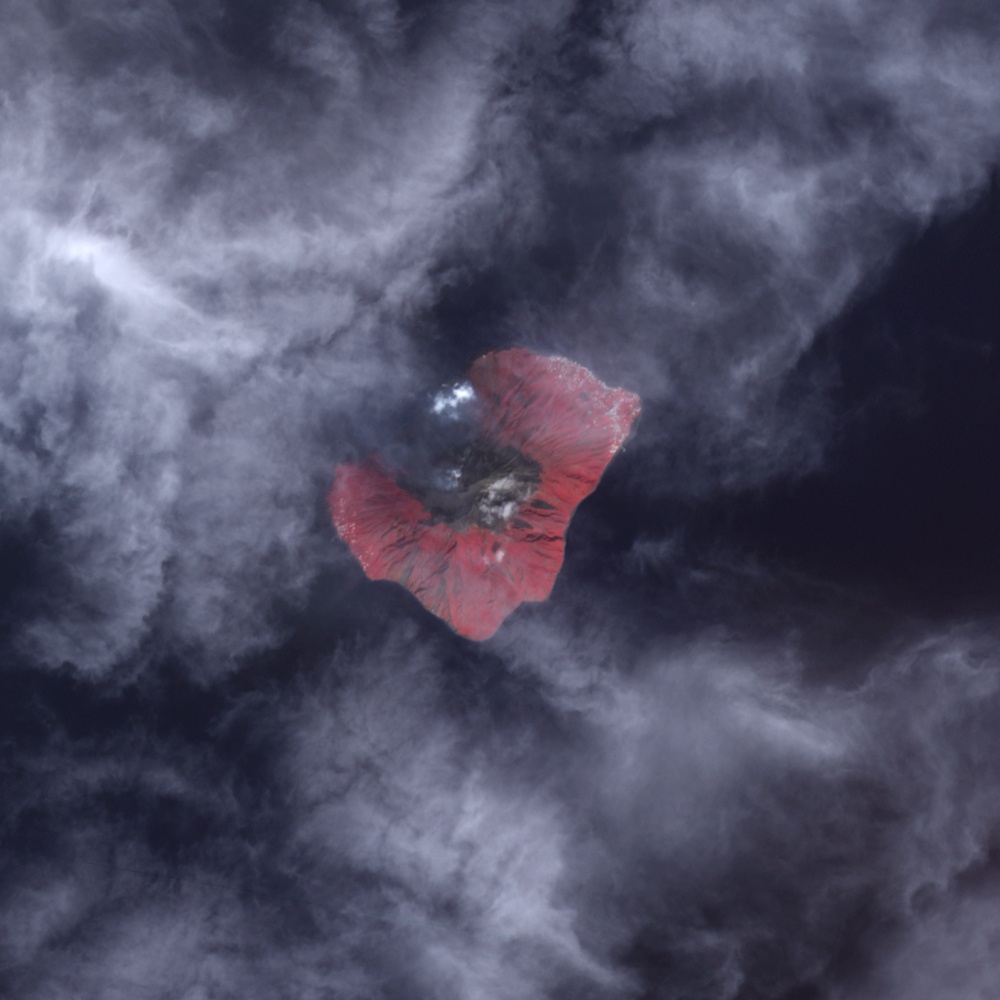Mount Stromboli is one of the busiest volcanoes on the planet. It’s been erupting off and on for thousands of years, and almost continuously since the early 1930s. So, it’s no surprise that ESA’s orbiting Copernicus Sentinel-2 mission caught its latest eruption in the act. It used infrared-sensitive instruments to chart the flow and follow its course to the sea.
Stromboli upped its action early Sunday, October 9th, sending huge pyroclastic flows down the mountain. Right after that, a “bench” of hardened lava from earlier flows collapsed. That revealed a fast-moving lava river that the ESA satellite saw from space. The image from Sentinel-2 highlights that superhot lava stream as it plunges down the mountain and into the sea.
The current lava flow is traveling in a feature called the Sciara del Fuoco (the Stream of Fire). It is the site where the ground collapsed about 5,000 years ago. The resulting scar provides a pathway for lava to flow down the mountain. It remains an active and very dangerous region. If it collapsed again, the resulting tsunami could have far-reaching effects on other islands in the region.
A Volcano’s Famous History
Stromboli created its own island, which is part of the Aeolian island chain in the Mediterranean. It rises up from a thousand meters below the surface of the Tyrrhenian Sea and towers up about 924 meters above sea level. Stromboli is long-lived. It has been continuously active for at least 2,000 years, and ancient mariners used it as a lighthouse. That’s because it erupted often. People could see the glow from those outbursts for miles across the open water. They called it the “Lighthouse of the Mediterranean.”
Stromboli is one of several volcanoes located along the Calabrian volcanic arc. Mount Etna on Sicily is part of that chain. These volcanic mountains formed as the African tectonic plate ducks under (subducts) the Eurasian plate. Volcanic arcs are fairly common around the world. There’s one in the Pacific Northwest in North America that built up Mount Hood, Mount Rainier, and Mount Saint Helens, for example. It’s where the Juan de Fuca, Explorer, and Gorda plates meet. The Pacific Ring of Fire also has these volcanic arcs and active volcanoes thanks to a subduction zone.
The subduction action gives Stromboli fuel for its eruptions. It first began building up about 200,000 years ago, building up an ancient volcano called Strombolicchio. That eventually eroded away, and about 160,000 years ago, the current Stromboli began erupting and forming its island. The mountain today is a “stratovolcano”, built up by the nearly constant eruptions.
Stromboli as a Prototype
When Stromboli erupts, it follows a pattern that geologists call “Strombolian”. That means an eruption that begins with “slugs” of gas rising up through the magma chamber in the mountain, through conduits to the surface. When the gases get to the surface, they explode and throw fountains of lava into the air. Over time, those bursts build up a lava cone. Sometimes there will be pyroclastic flows, which are fast-moving clouds of gas and lava debris that barrel down the mountain. Other mountains around the world also send similar “Strombolian” flows out, patterned after the famous namesake.

Volcanic activity is one of several processes that change Earth’s surface. ESA’s satellite is not the only one tracking its activity. NASA’s Advanced Spaceborne Thermal Emission and Reflection Radiometer on the TERRA satellite also captured views of it in 2007. Ongoing space-based studies augment ground-based monitoring of this and other volcanoes to track how they change over time.
For Stromboli and the few hundred inhabitants of this island, continuing activity risks life and property. The island is often rocked by earthquakes. These indicate the movement of magma below the surface. The eruptions themselves can destroy homes and villages. For those reasons, most inhabitants left the island, migrating to other islands.
Stromboli in Literature and on Our Plates
Interestingly, Stromboli is a prototype for more than just its type of eruption. It shows up in popular culture as well. The widely read Tolkien trilogy “Lord of the Rings” features “Mount Doom” where the hobbits bring the Ring of Power. Author J.R.R. Tolkien reportedly used Stromboli as an inspiration for that famous fictional volcano. In addition, Jules Verne has his adventurers exit from their trip to the Earth’s core via Stromboli in his book “Journey to the Center of the Earth.” The 1950 film “Stromboli” features a story about people who live on the island. That inspired a dish called a Stromboli, which is a kind of Italian meat and cheese sandwich. No word on whether it’s melty hot, just like its namesake.
For More Information
The post Satellite View of Stromboli’s New Eruption in Italy. You Can See a River of Lava Flowing to the Ocean appeared first on Universe Today.
No comments:
Post a Comment